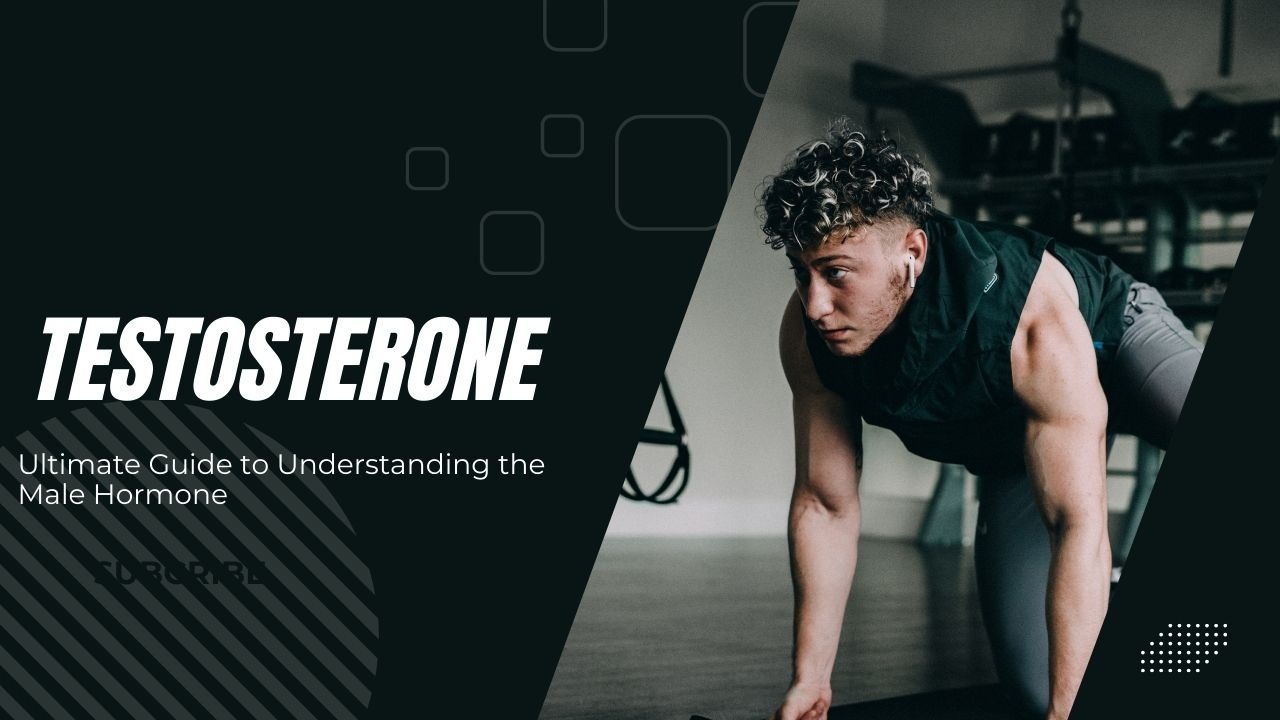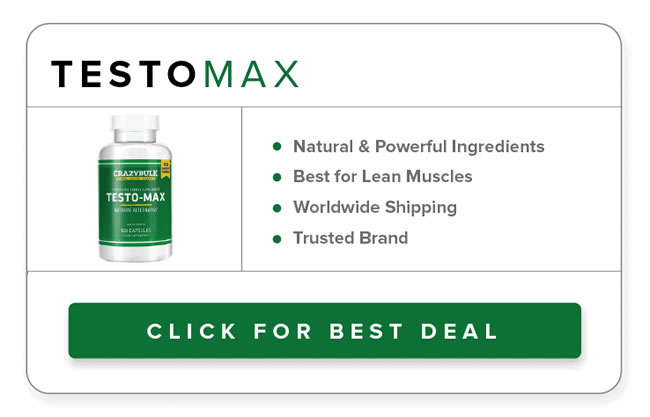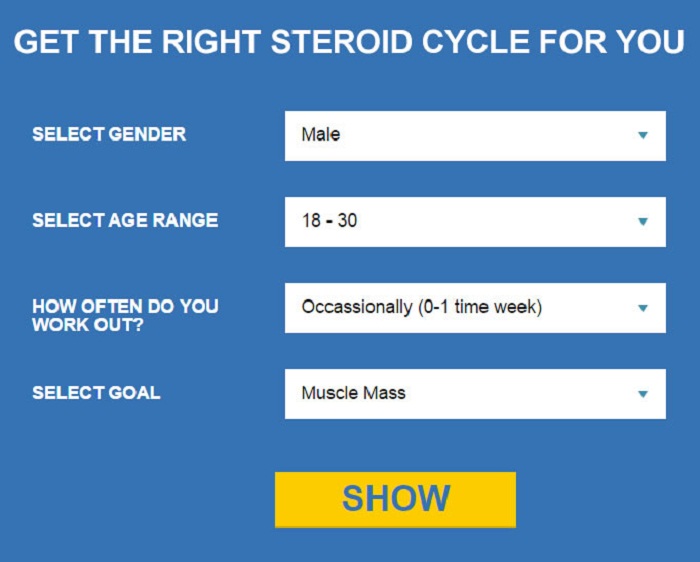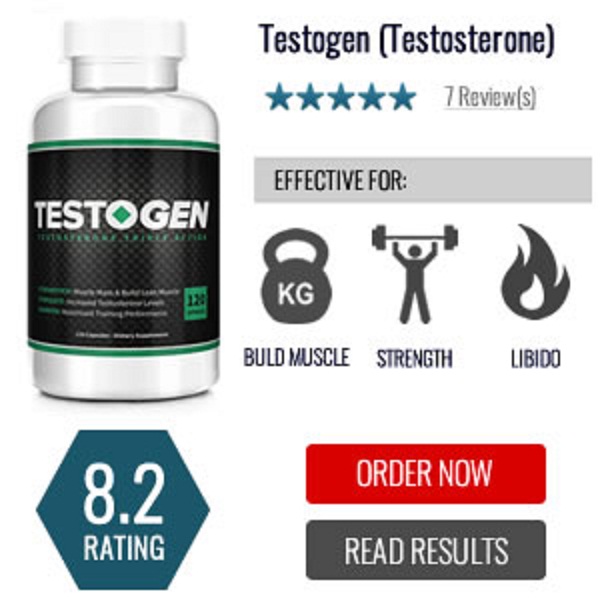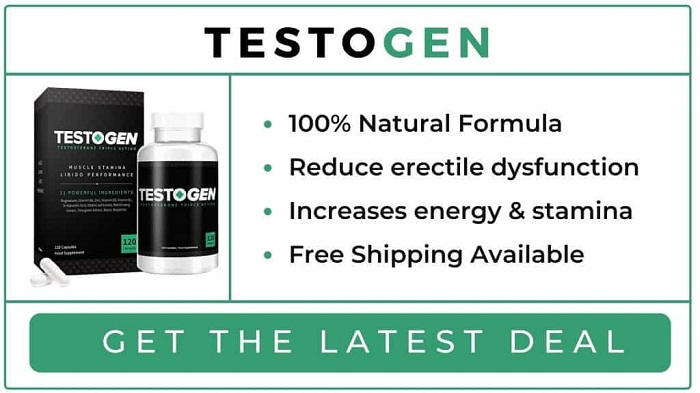Testosterone Guide
Contents
- 1 Testosterone Guide
- 2 What is Testosterone?
- 3 Functions of Testosterone
- 4 Normal Testosterone Levels
- 5 Signs and Symptoms of Low Testosterone
- 6 Diagnosis of Low Testosterone
- 7 Treatment Options for Low Testosterone
- 8 Potential Risks and Side Effects of TRT
- 9 Testosterone vs. Steroids: Understanding the Difference
- 10 Testosterone Boosters Available in the Market: A Critical Look
- 11 Tribulus Terrestris:
- 12 D-Aspartic Acid (DAA):
- 13 Fenugreek:
- 14 Ashwagandha:
- 15 Zinc and Magnesium:
- 16 Important Considerations:
- 17 Editor’s Choice: Testogen
- 18 Maintaining Healthy Testosterone Levels
- 19 Conclusion
- 20 Frequently Asked Questions (FAQ)
- 21 References
Testosterone, the quintessential male hormone, plays a vital role in shaping a man’s physical and mental well-being. From fueling muscle growth and sex drive to maintaining bone health and mood regulation, testosterone’s influence is undeniable. This comprehensive guide delves into the world of testosterone, exploring its functions, potential imbalances, and strategies for optimal levels.
Must Check: Best Testosterone Boosters on the Market | The Comprehensive Guide
Men are often stereotyped by their testosterone levels. This powerful hormone, though associated with masculinity, has a nuanced and multifaceted role in the male body. It’s crucial for sexual development and function, but its impact extends far beyond reproduction. Testosterone is an orchestra conductor, directing a symphony of processes that maintain a man’s overall health.
However, misconceptions and misinformation often surround testosterone. Some view it as a magic bullet for building muscle or boosting performance, while others fear its potential side effects. This article aims to shed light on the science behind testosterone, separating fact from fiction. We’ll explore its functions, the factors affecting its levels, and how to maintain optimal balance for a healthy and fulfilling life.
What is Testosterone?
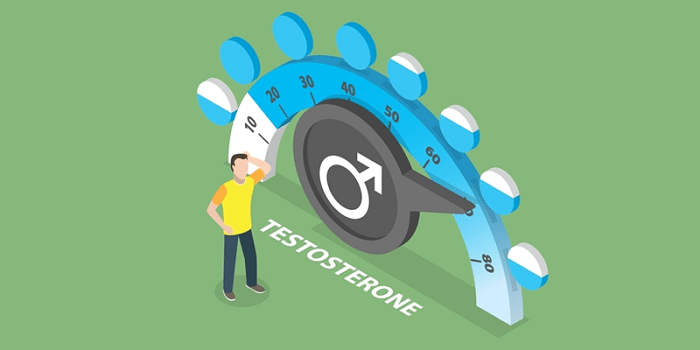
Chemically classified as an androgen, testosterone is the primary male sex hormone. Produced mainly in the Leydig cells of the testicles, smaller amounts are also synthesized in the adrenal glands. The hypothalamus and pituitary gland, located in the brain, form a control center, regulating testosterone production through a feedback loop.
Functions of Testosterone
Testosterone’s influence across various systems in the male body is extensive. Let’s delve into its key functions:
- Sexual Development and Function: During puberty, testosterone surges, triggering the development of male reproductive organs like the penis, testicles, and prostate gland. It also promotes the growth of facial and body hair, deepening the voice, and increasing sperm production. Testosterone fuels sex drive (libido) and plays a role in erectile function.
- Muscle and Bone Growth: Testosterone is a potent anabolic steroid, meaning it promotes tissue growth. It stimulates protein synthesis in muscle cells, leading to increased muscle mass and strength. Additionally, testosterone strengthens bones by increasing mineral density, preventing osteoporosis and fractures.
- Red Blood Cell Production: Testosterone stimulates the production of erythropoietin, a hormone that increases red blood cell production. This translates to better oxygen delivery throughout the body, enhancing energy levels and endurance.
- Other Functions: Testosterone plays a role in mood regulation, influencing cognitive function, memory, and motivation. It also impacts fat distribution, promoting a more masculine physique and regulating energy metabolism.
Normal Testosterone Levels
Testosterone levels naturally fluctuate throughout a man’s life. They peak in early adulthood, typically between the ages of 20 and 30, and then gradually decline by about 1% per year after that. Several factors can influence testosterone levels:
- Age: As mentioned, testosterone levels decrease with age. This decline is a natural part of the aging process, but the rate of decline can vary.
- Weight: Obesity can negatively impact testosterone production. Excess body fat tissue converts testosterone into estrogen, leading to lower testosterone levels.
- Genetics: Some men are genetically predisposed to having lower or higher testosterone levels.
- Medical Conditions: Certain medical conditions like Klinefelter’s syndrome, hypogonadism (impaired testicular function), and chronic illnesses can affect testosterone production.
- Lifestyle Habits: Diet, exercise, sleep, and stress levels all play a role in testosterone levels. Poor diet, lack of exercise, inadequate sleep, and chronic stress can contribute to lower testosterone.
It’s important to note that “normal” testosterone levels can vary depending on the reference range used by different laboratories. Furthermore, levels alone might not paint the whole picture. Consulting a doctor to understand your situation is crucial.
Signs and Symptoms of Low Testosterone
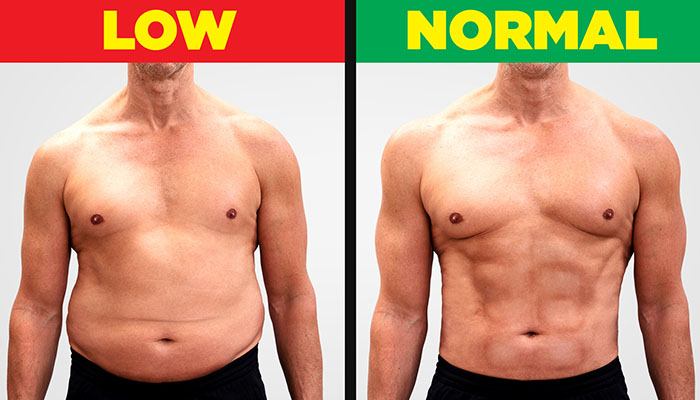
A significant drop in testosterone levels can manifest in various symptoms, including:
- Decreased libido and sexual function: Low testosterone can lead to a decline in sex drive, erectile dysfunction, and difficulty achieving orgasm.
- Fatigue and decreased energy levels: Testosterone plays a role in energy production and metabolism. Low levels can result in chronic fatigue and a lack of motivation.
- Mood changes and irritability: Testosterone is linked to mood regulation. A decline can lead to irritability, depression, or anxiety.
- Muscle loss and weight gain: Low testosterone can lead to a decrease in muscle mass and an increase in body fat, particularly around the midsection.
- Decreased bone density: As mentioned earlier, testosterone helps maintain bone health. Low levels can increase the risk of osteoporosis and fractures.
- Sleep disturbances: Testosterone can influence sleep quality. Low levels might contribute to sleep apnea or difficulty falling asleep.
- Loss of body hair and thinning hair: Reduced testosterone can contribute to a decrease in body hair and potentially accelerate male pattern baldness.
- Gynecomastia: In rare cases, low testosterone can lead to the development of breast tissue in men (gynecomastia).
It’s important to remember that these symptoms can also be caused by other underlying medical conditions. If you experience several of these symptoms, consulting a healthcare professional for a proper diagnosis is crucial.
Diagnosis of Low Testosterone
Diagnosing low testosterone typically involves a two-pronged approach:
- Medical history and physical examination: Your doctor will discuss your symptoms, medical history, and lifestyle habits. A physical examination may be conducted to assess signs of low testosterone, such as decreased muscle mass or changes in body hair distribution.
- Blood tests: Blood tests measure your total and free testosterone levels. Total testosterone reflects the amount of testosterone circulating in the blood, bound to proteins or free-floating. Free testosterone is the biologically active form responsible for exerting its effects on the body. Your doctor will interpret the results based on your age, reference range used by the lab, and overall clinical picture.
Sometimes, additional tests might be recommended to rule out other conditions that could be causing similar symptoms.
Treatment Options for Low Testosterone
If a diagnosis of low testosterone is confirmed and your symptoms warrant treatment, several options are available:
- Testosterone Replacement Therapy (TRT): TRT is the most common treatment for low testosterone. It aims to restore testosterone levels to the normal range and alleviate symptoms. TRT comes in various forms:
- Injections: Testosterone injections are a popular and effective option. They can be administered weekly or bi-weekly, depending on the specific testosterone ester used.
- Gels: Testosterone gels are applied directly to the skin, typically the shoulders or upper arms. This method is convenient and avoids needles, but consistent application is crucial for optimal results.
- Patches: Testosterone patches are worn on the scrotum and release testosterone through the skin. They offer a convenient option but may cause skin irritation in some men.
- Pellets: Testosterone pellets are implanted subcutaneously (under the skin) and release testosterone slowly over several months. This is a less common option but can be appealing to those who dislike frequent injections or applications.
- Lifestyle Modifications: Lifestyle changes can promote healthy testosterone levels, even if not a direct replacement therapy. These include:
- Diet: A balanced diet rich in fruits, vegetables, whole grains, and lean protein can support testosterone production. Limiting processed foods, unhealthy fats, and excessive sugar intake can also be beneficial.
- Exercise: Regular exercise, particularly strength training, can stimulate testosterone production and improve overall health. Aim for at least 30 minutes of moderate-intensity exercise most days of the week.
- Weight management: Losing weight if overweight or obese can significantly improve testosterone levels.
- Sleep: Getting adequate sleep (7-8 hours per night) is crucial for optimal testosterone production.
- Stress management: Chronic stress can lower testosterone levels. Techniques like meditation, yoga, and deep breathing can help manage stress and improve overall well-being.
Your doctor will discuss the most suitable treatment approach based on your individual needs and preferences. It’s important to understand the potential benefits and risks of TRT before starting treatment.
Potential Risks and Side Effects of TRT
While TRT can be an effective treatment for low testosterone, it’s not without potential risks and side effects. Some of these include:
- Increased red blood cell count: High red blood cell count (erythrocytosis) can increase the risk of blood clots. Regular blood tests are necessary to monitor red blood cell levels during TRT.
- Acne: TRT can trigger acne breakouts, especially in men predisposed to acne.
- Breast enlargement (gynecomastia): In rare cases, TRT can cause breast tissue enlargement.
- Shrinking of testicles: TRT can suppress the natural production of testosterone by the testicles, leading to shrinkage. This is usually temporary and reversible upon stopping TRT.
- Fertility issues: TRT can temporarily impair sperm production. If you plan to father children, discuss this with your doctor beforehand.
- Sleep apnea: TRT may worsen sleep apnea symptoms in some men.
It’s crucial to have an open and honest conversation with your doctor about these potential risks and side effects before starting TRT. Regular monitoring by your doctor is essential throughout treatment to ensure optimal outcomes and address any potential issues.
Testosterone vs. Steroids: Understanding the Difference
Testosterone and steroids are often used interchangeably, creating confusion. However, a clear distinction exists between these two substances. Testosterone is a naturally occurring hormone produced by the body, primarily in the testicles for men and ovaries for women, though in much smaller amounts. It plays a vital role in various bodily functions, including muscle and bone growth, sex drive, and red blood cell production. In contrast, steroids encompass a broader category of synthetic substances designed to mimic the effects of testosterone. These synthetic steroids, also known as anabolic-androgenic steroids (AAS), are manufactured in labs and come in various forms, including pills, injections, and gels.
The key difference lies in purpose and dosage. Testosterone replacement therapy (TRT) uses small, carefully measured doses of testosterone to address deficiencies caused by conditions like hypogonadism, a condition where the body doesn’t produce enough testosterone naturally. TRT aims to restore hormonal balance and alleviate symptoms associated with low testosterone, such as decreased libido, fatigue, and muscle loss. It’s a medical treatment overseen by a doctor, who monitors hormone levels and adjusts dosages as needed to ensure safety and effectiveness.
Anabolic steroids, on the other hand, are often misused by athletes or bodybuilders seeking to achieve rapid muscle growth and enhanced performance. These individuals typically take much higher doses of steroids compared to TRT regimens. This excessive intake pushes the body beyond its natural capacity, leading to a significant risk of side effects. Potential complications associated with anabolic steroid use include liver damage, increased risk of heart problems, mood swings, and aggression. In some cases, these effects can be permanent.
It’s crucial to understand the stark differences between testosterone and anabolic steroids. TRT is a legitimate medical treatment with potential benefits for individuals with diagnosed testosterone deficiencies. It’s administered under strict medical supervision to ensure safety and effectiveness. Conversely, anabolic steroid use is illegal for non-medical purposes and carries serious health risks.
Testosterone Boosters Available in the Market: A Critical Look
The desire to optimize testosterone levels has fueled a multi-billion dollar industry for testosterone boosters. These supplements, often marketed with aggressive claims and impressive-sounding ingredients, promise a natural solution to low testosterone woes. However, the reality is far more nuanced. Here’s a deeper dive into some commonly available testosterone boosters and the science behind them:
Tribulus Terrestris:
- Traditional Uses: This flowering vine has a long history of use in traditional medicine for enhancing libido and sexual function.
- Scientific Evidence: Studies investigating Tribulus Terrestris’ impact on testosterone levels have yielded mixed results. Some small-scale studies suggest potential benefits, particularly for athletes with low baseline testosterone. However, larger, more robust studies are needed to draw definitive conclusions.
D-Aspartic Acid (DAA):
- Function: This amino acid plays a role in the cascade of hormone production that leads to testosterone synthesis.
- Research: While DAA shows promise in stimulating testosterone production in animals, its effectiveness in humans, particularly healthy men with normal testosterone levels, remains questionable. More research is needed to determine its efficacy and optimal dosage.
Fenugreek:
- Traditional Uses: This herb has been used for centuries in various cultures to manage blood sugar and enhance libido.
- Testosterone Effects: Studies on Fenugreek’s ability to directly boost testosterone levels are inconclusive. However, some research suggests it may improve symptoms of low testosterone, such as decreased libido.
Ashwagandha:
- Adaptogenic Properties: This ancient medicinal herb is known as an adaptogen, meaning it helps the body adapt to stress.
- Testosterone and Stress: Chronic stress can negatively impact testosterone levels. Ashwagandha’s stress-relieving properties might indirectly support healthy testosterone levels. However, research specifically on Ashwagandha’s ability to directly increase testosterone is inconclusive.
Zinc and Magnesium:
- Essential Minerals: Zinc and magnesium are crucial for various bodily functions, including testosterone production. Deficiencies in these minerals can negatively impact testosterone levels.
- Supplementation: If you have a confirmed deficiency in zinc or magnesium, supplementation can be beneficial. However, for individuals with adequate levels, supplementation might not offer significant benefits for testosterone.
Important Considerations:
- Limited Scientific Evidence: Many testosterone boosters lack strong scientific backing to support claims of significantly increasing testosterone in healthy men.
- Potential Side Effects: Some boosters may interact with medications or cause side effects like digestive upset, headaches, or acne.
- Regulation Concerns: Dietary supplements are not as stringently regulated as prescription medications. Quality and ingredient consistency can vary greatly between brands.
Editor’s Choice: Testogen
It’s important to note that we cannot endorse any specific product. However, some testosterone boosters like Testogen combine many of the ingredients mentioned above:
- Tribulus Terrestris
- D-Aspartic Acid (DAA)
- Fenugreek
- Ashwagandha
- Zinc
- Magnesium
- Vitamin D3
- Korean Red Ginseng
- Boron
Remember: While Testogen contains these ingredients, the effectiveness of these combinations in significantly boosting testosterone levels in healthy men is a subject of ongoing research.
Maintaining Healthy Testosterone Levels
Even if you don’t have low testosterone, there are steps you can take to promote healthy testosterone levels and optimize your overall well-being:
- Maintain a Healthy Diet:
- Focus on a balanced diet rich in fruits, vegetables, and whole grains. These foods provide essential nutrients that support testosterone production.
- Include healthy fats like those found in fatty fish, avocados, nuts, and seeds. These fats play a role in hormone production and regulation.
- Choose lean protein sources like chicken, fish, beans, and lentils. Protein is crucial for building and maintaining muscle mass, which can indirectly support testosterone levels.
- Limit processed foods, sugary drinks, and unhealthy fats. These can negatively impact testosterone production and overall health.
- Prioritize Strength Training: Engage in regular exercise, particularly strength training. Aim for at least two to three strength training sessions per week, focusing on major muscle groups. Strength training stimulates testosterone production and helps build muscle mass, leading to a positive feedback loop.
- Manage Weight: Maintain a healthy weight. Obesity can significantly decrease testosterone levels. Losing weight if overweight or obese can improve testosterone production and overall health.
- Get Enough Sleep: Aim for 7-8 hours of quality sleep each night. Sleep deprivation can disrupt hormone regulation, including testosterone production. Develop a regular sleep schedule and practice good sleep hygiene to ensure restful sleep.
- Manage Stress: Chronic stress can lower testosterone levels. Find healthy ways to manage stress, such as exercise, meditation, yoga, or spending time in nature. Relaxation techniques can help regulate stress hormones and potentially improve testosterone production.
- Limit Alcohol Consumption: Excessive alcohol consumption can negatively impact testosterone production and overall health. Moderate alcohol intake or abstinence might be beneficial for testosterone levels.
- Consider Natural Testosterone Boosters: While many natural testosterone boosters are available in the market, their effectiveness is often limited and not always supported by strong scientific evidence. Consult your doctor before taking any supplements to discuss potential benefits and risks and ensure they won’t interfere with any medications you’re taking.
- Focus on a holistic approach to maintain healthy testosterone levels. By incorporating these lifestyle modifications into your routine, you can promote optimal hormone function and support your overall health and well-being.
Conclusion
Testosterone, the cornerstone of male health, plays a vital role in physical and mental well-being. Understanding its functions, the factors affecting its levels, and the options available for addressing imbalances empowers men to take charge of their health. Remember, consulting a healthcare professional is crucial for diagnosis, treatment plans, and monitoring testosterone levels. By working with your doctor and adopting healthy lifestyle practices, you can maintain optimal testosterone levels and experience a fulfilling and healthy life.
Frequently Asked Questions (FAQ)
What are the benefits of testosterone replacement therapy (TRT)?
TRT can alleviate symptoms of low testosterone, such as decreased libido, erectile dysfunction, fatigue, and mood changes. It can also improve muscle mass and bone density.
What are the risks of low testosterone?
Low testosterone can lead to various health problems, including decreased libido, erectile dysfunction, infertility, muscle loss, increased body fat, osteoporosis, and mood changes.
Are there natural ways to boost testosterone levels?
There are lifestyle modifications that can promote healthy testosterone levels, such as maintaining a balanced diet, regular exercise (especially strength training), weight management, adequate sleep, stress management, and limiting alcohol consumption. However, the effectiveness of natural supplements for boosting testosterone is often limited and requires further research.
When should I see a doctor about low testosterone?
If you experience symptoms suggestive of low testosterone, such as decreased libido, erectile dysfunction, fatigue, mood changes, or unexplained muscle loss, consult your doctor for evaluation and diagnosis.
What tests are used to diagnose low testosterone?
Diagnosis of low testosterone typically involves a medical history and physical examination alongside blood tests to measure total and free testosterone levels.
References
- National Institutes of Health (NIH): Testosterone https://www.ncbi.nlm.nih.gov/pmc/articles/PMC4674408/
- Mayo Clinic: Low testosterone in men: Symptoms and causes https://www.urologyhealth.org/urology-a-z/l/low-testosterone
- Urology Care Foundation: Testosterone Replacement Therapy https://www.urologyhealth.org/educational-resources/testosterone-therapy
- Endocrine Society: Testosterone Therapy in Men with Hypogonadism https://pubmed.ncbi.nlm.nih.gov/29562364/
- American College of Sports Medicine: ACSM Position Stand on the Optimal Exercise Dose for Adults https://pubmed.ncbi.nlm.nih.gov/21694556/
Disclaimer: This article provides general information and is not a substitute for professional medical advice. Always consult your doctor for any questions or concerns you may have regarding your testosterone levels or treatment options.
